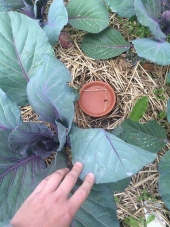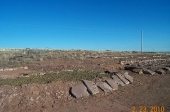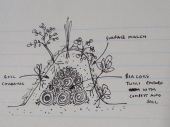
















Son of Levin wrote: I don't know that this fits here, as it seems most responses have been regarding outdoor, in-ground applications, but I'll post it nevertheless. As with many things I do, it is a miniaturization of large-scale commercial methods; in this case, the system used by a local greenhouse. And as with some of the things I do, there have been happy accidents. I welcome suggestions for improvements, and I apologize for the lack of pictures in advance.
First, a bit of context: I'm currently growing vegetables way back in the woods with no power and no well. There is a seasonal stream, however. We have a greenhouse, which is wood-heated.
I bought food grade blue 55-gallon drums, arranged them in a line down the center of the greenhouse about 4' apart and made sure the tops were all level. Then I wrapped a 3/4" sheet of plywood in 6 mil poly and screwed on 2x4 sides. That is placed atop/spans three barrels, leaving the openings (there is a 3" threaded plastic cap in my barrels) of barrels 1 and 3 open. Into that opening I drop a plastic hand-pump that is ordinarily used for moving fuel from drums to vehicles and which I use to flood the tables with the water in the barrels.
In the winter, when we're lighting fires to keep the seedlings from freezing, I keep water in the barrels to store heat. The mass of the water has the additional benefit of making the barrels extremely good support pillars for the watering table. Now that it's warming up and the weather is becoming more microbially friendly, I don't store as much, and make sure to thoroughly empty a barrel before I recharge it. Water is gravity fed - through a sand filter - from the stream via 2" lay-flat. This time of year, I just tuck the lay-flat into the corner of a table and let 'er rip.
I start seeds in soil blocks in trays with fairly open bottoms. The benefits of bottom-watering and soil blocks have been enumerated elsewhere, so I won't go into them here. One caution, from the greenhouse owner, regards fertigation: you should use an EC meter (I know, it's fancy-schmancy) to check the build-up of fertilizer salts (I know, you all don't use such and neither do I, but still...) in your plugs/blocks, as this system lacks the flushing action of overhead watering.
So you flood the table, wait fifteen minutes at most, or until it seems that your plants have what they need.
The depth to which you flood depends on the size of your blocks/plugs - the larger they are, the deeper the water needs to be to wick up through the block in the time limit. Then you pull the drain-plug and the water exits the system. Where it goes is up to you, and fertile ground for creativity.
I mentioned before that the tops of the barrels were leveled. I shim to create just enough slope to drain the table when I pull the plug. In the commercial greenhouse these tables are 20' long with one end 1/4" higher than the other.
There are problems with this system on a philosophical level for me. I hate using so much plastic, and having it all bake in the sun day after day. I am aware of the extremely inefficient use of wood when used to heat the air in a stand-alone greenhouse without so much as an inflater fan. Practical hurdles are getting three barrels to stand in the same plane so that the watering table is supported on each end and in the middle. If it isn't, there is a surprising amount of deflection under the weight of the flats, and that results in uneven water distribution and hence, rate of uptake.
But: if the tables could be stiffened enough, and if they could be properly (read:evenly) supported, and if the various plastic components could be replaced with wooden/bamboo/glass counterparts, and if this all took place in a structure attached to it that could share some of that heat we're throwing off from the stove, and if the water exited to somewhere that could use it well, I'd feel pretty good about the whole thing.
Some other ideas include the creative reuse of pick-up bedliners, but I don't know that it would be worth it.








 1
1




Our inability to change everything should not stop us from changing what we can.





 3
3




How Permies works: https://permies.com/wiki/34193/permies-works-links-threads
My projects on Skye: The tree field, Growing and landracing, perennial polycultures, "Don't dream it - be it! "
 3
3




Invasive plants are Earth's way of insisting we notice her medicines. Stephen Herrod Buhner
Everyone learns what works by learning what doesn't work. Stephen Herrod Buhner
 3
3




Invasive plants are Earth's way of insisting we notice her medicines. Stephen Herrod Buhner
Everyone learns what works by learning what doesn't work. Stephen Herrod Buhner












 4
4




How Permies works: https://permies.com/wiki/34193/permies-works-links-threads
My projects on Skye: The tree field, Growing and landracing, perennial polycultures, "Don't dream it - be it! "
 3
3




--
"Whitewashed Hope: A Message from 10+ Indigenous Leaders and Organizations"
https://www.culturalsurvival.org/news/whitewashed-hope-message-10-indigenous-leaders-and-organizations












 3
3




How Permies works: https://permies.com/wiki/34193/permies-works-links-threads
My projects on Skye: The tree field, Growing and landracing, perennial polycultures, "Don't dream it - be it! "
 3
3




--
"Whitewashed Hope: A Message from 10+ Indigenous Leaders and Organizations"
https://www.culturalsurvival.org/news/whitewashed-hope-message-10-indigenous-leaders-and-organizations

|
There are 10 kinds of people in this world. Those that understand binary get this tiny ad:
Freaky Cheap Heat - 2 hour movie - HD streaming
https://permies.com/wiki/238453/Freaky-Cheap-Heat-hour-movie
|








